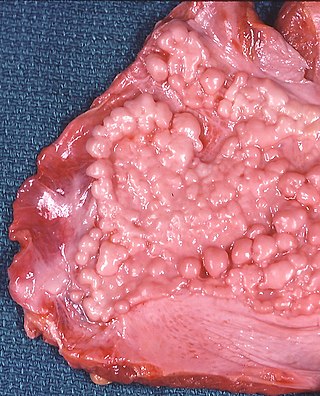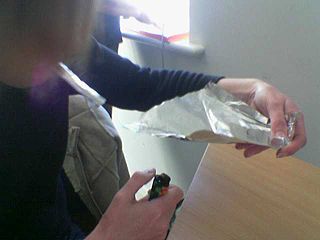
A carcinogen is any substance, radionuclide, or radiation that promotes carcinogenesis. This may be due to the ability to damage the genome or to the disruption of cellular metabolic processes. Several radioactive substances are considered carcinogens, but their carcinogenic activity is attributed to the radiation, for example gamma rays and alpha particles, which they emit. Common examples of non-radioactive carcinogens are inhaled asbestos, certain dioxins, and tobacco smoke. Although the public generally associates carcinogenicity with synthetic chemicals, it is equally likely to arise from both natural and synthetic substances. Carcinogens are not necessarily immediately toxic; thus, their effect can be insidious.

Talc, or talcum, is a clay mineral composed of hydrated magnesium silicate, with the chemical formula Mg3Si4O10(OH)2. Talc in powdered form, often combined with corn starch, is used as baby powder. This mineral is used as a thickening agent and lubricant. It is an ingredient in ceramics, paints, and roofing material. It is a main ingredient in many cosmetics. It occurs as foliated to fibrous masses, and in an exceptionally rare crystal form. It has a perfect basal cleavage and an uneven flat fracture, and it is foliated with a two-dimensional platy form.

Johnson & Johnson (J&J) is an American multinational, pharmaceutical, and medical technologies corporation headquartered in New Brunswick, New Jersey, and publicly traded on the New York Stock Exchange. Its common stock is a component of the Dow Jones Industrial Average, and the company is ranked No. 40 on the 2023 Fortune 500 list of the largest United States corporations. In 2023, the company was ranked 40th in the Forbes Global 2000. Johnson & Johnson has a global workforce of approximately 130,000 employees who are led by the company's current chairman and chief executive officer, Joaquin Duato.

Mesothelioma is a type of cancer that develops from the thin layer of tissue that covers many of the internal organs. The area most commonly affected is the lining of the lungs and chest wall. Less commonly the lining of the abdomen and rarely the sac surrounding the heart, or the sac surrounding the testis may be affected. Signs and symptoms of mesothelioma may include shortness of breath due to fluid around the lung, a swollen abdomen, chest wall pain, cough, feeling tired, and weight loss. These symptoms typically come on slowly.

Episiotomy, also known as perineotomy, is a surgical incision of the perineum and the posterior vaginal wall generally done by an obstetrician. This is usually performed during the second stage of labor to quickly enlarge the aperture, allowing the baby to pass through. The incision, which can be done from the posterior midline of the vulva straight toward the anus or at an angle to the right or left, is performed under local anesthetic, and is sutured after delivery.

Ovarian cancer is a cancerous tumor of an ovary. It may originate from the ovary itself or more commonly from communicating nearby structures such as fallopian tubes or the inner lining of the abdomen. The ovary is made up of three different cell types including epithelial cells, germ cells, and stromal cells. When these cells become abnormal, they have the ability to divide and form tumors. These cells can also invade or spread to other parts of the body. When this process begins, there may be no or only vague symptoms. Symptoms become more noticeable as the cancer progresses. These symptoms may include bloating, vaginal bleeding, pelvic pain, abdominal swelling, constipation, and loss of appetite, among others. Common areas to which the cancer may spread include the lining of the abdomen, lymph nodes, lungs, and liver.

Asbestosis is long-term inflammation and scarring of the lungs due to asbestos fibers. Symptoms may include shortness of breath, cough, wheezing, and chest tightness. Complications may include lung cancer, mesothelioma, and pulmonary heart disease.

Cornflour, cornstarch, maize starch, or corn starch is the starch derived from corn (maize) grain. The starch is obtained from the endosperm of the kernel. Corn starch is a common food ingredient, often used to thicken sauces or soups, and to make corn syrup and other sugars. Corn starch is versatile, easily modified, and finds many uses in industry such as adhesives, in paper products, as an anti-sticking agent, and textile manufacturing. It has medical uses as well, such as to supply glucose for people with glycogen storage disease.
Occupational lung diseases comprise a broad group of diseases, including occupational asthma, industrial bronchitis, chronic obstructive pulmonary disease (COPD), bronchiolitis obliterans, inhalation injury, interstitial lung diseases, infections, lung cancer and mesothelioma. These can be caused directly or due to immunological response to an exposure to a variety of dusts, chemicals, proteins or organisms. Occupational cases of interstitial lung disease may be misdiagnosed as COPD, idiopathic pulmonary fibrosis, or a myriad of other diseases; leading to a delay in identification of the causative agent.

"Chasing the dragon" (CTD), or "foily" in Australian English, refers to inhaling the vapor of a powdered psychoactive drug off a heated sheet of aluminum foil. The moving vapor is chased after with a tube through which the user inhales. The "chasing" occurs as the user gingerly keeps the liquid moving in order to keep it from overheating and burning up too quickly, on a heat conducting material such as aluminium foil.
Dosage forms are pharmaceutical drug products in the form in which they are marketed for use, with a specific mixture of active ingredients and inactive components (excipients), in a particular configuration, and apportioned into a particular dose. For example, two products may both be amoxicillin, but one is in 500 mg capsules and another is in 250 mg chewable tablets. The term unit dose can also sometimes encompass non-reusable packaging as well, although the FDA distinguishes that by unit-dose "packaging" or "dispensing". Depending on the context, multi(ple) unit dose can refer to distinct drug products packaged together, or to a single drug product containing multiple drugs and/or doses. The term dosage form can also sometimes refer only to the pharmaceutical formulation of a drug product's constituent drug substance(s) and any blends involved, without considering matters beyond that. Because of the somewhat vague boundaries and unclear overlap of these terms and certain variants and qualifiers within the pharmaceutical industry, caution is often advisable when conversing with someone who may be unfamiliar with another person's use of the term.

Dietary factors are recognized as having a significant effect on the risk of cancers, with different dietary elements both increasing and reducing risk. Diet and obesity may be related to up to 30–35% of cancer deaths, while physical inactivity appears to be related to 7% risk of cancer occurrence.

William Mark Lanier is an American trial lawyer and founder and CEO of the Lanier Law Firm. He has led a number of high-profile product litigation suits resulting in billions of dollars in damages, including Johnson & Johnson baby powder and Merck & Co.'s Vioxx drug.

Asbestos is a naturally occurring fibrous silicate mineral. There are six types, all of which are composed of long and thin fibrous crystals, each fibre being composed of many microscopic "fibrils" that can be released into the atmosphere by abrasion and other processes. Inhalation of asbestos fibres can lead to various dangerous lung conditions, including mesothelioma, asbestosis, and lung cancer. As a result of these health effects, asbestos is considered a serious health and safety hazard.
Cancer is caused by genetic changes leading to uncontrolled cell growth and tumor formation. The basic cause of sporadic (non-familial) cancers is DNA damage and genomic instability. A minority of cancers are due to inherited genetic mutations. Most cancers are related to environmental, lifestyle, or behavioral exposures. Cancer is generally not contagious in humans, though it can be caused by oncoviruses and cancer bacteria. The term "environmental", as used by cancer researchers, refers to everything outside the body that interacts with humans. The environment is not limited to the biophysical environment, but also includes lifestyle and behavioral factors.

Johnson's Baby is an American brand of baby cosmetics and skin care products owned by Kenvue. The brand was introduced in 1893 with Johnson's Baby Powder. The product line consists of baby powder, shampoos, body lotions, massage oil, shower gels and baby wipes.
Levy Konigsberg is an American-based law firm that was established in 1985. The company is known for a number of high-profile cases in the United States. Its practice areas include asbestos litigation, qui tam, lead poisoning, sexual abuse, tobacco litigation, medical malpractice, and negligence. In 2015, Levy Konigsberg was recognized as one of the 50 Law Firms in the 2015 Elite Trial Lawyers list by The National Law Journal.

Toxicology of carbon nanomaterials is the study of toxicity in carbon nanomaterials like fullerenes and carbon nanotubes.
ChemRisk is a Delaware Limited Liability Company, a for-profit scientific consulting firm headquartered in San Francisco, California that is part of Cardno ChemRisk. ChemRisk founder and former president, Dennis Paustenbach, "has long been an expert witness and top consultant" to "scores of companies in the chemical, energy and medical products industries" facing lawsuits over products or environmental practices or product safety. Their clients included San Francisco-based utility Pacific Gas & Electric (PG&E) and BP. ChemRisk uses toxicology and risk assessment to measure the hazards of chemicals in soil, air, water, food, sediments and consumer products.

Toxic Beauty is a 2019 Canadian-American documentary film about exposure to dangerous substances from commonly trusted beauty products such as baby powder. Directed by Phyllis Ellis and produced by White Pine Pictures, the film premiered at the April 2019 Hot Docs Canadian International Documentary Festival. The documentary follows the experiences and motivations of beauty product consumers as well as the experience of cancers caused by brand-name cosmetics, including but not limited to Johnson & Johnson. Features include interviews with scientists, doctors, and lawyers about the issues surrounding a substandard regulation system, and scientist Mymy Nguyen's journey of discovery as she seeks to replace commonly used products with safer ones.

















